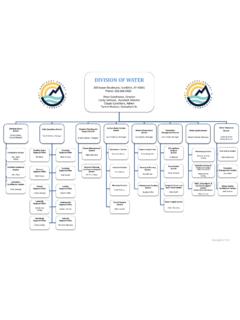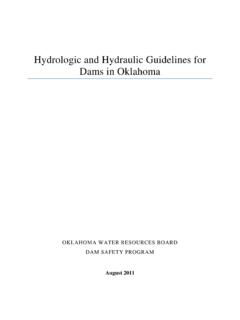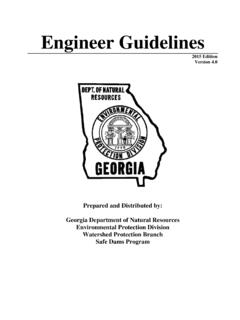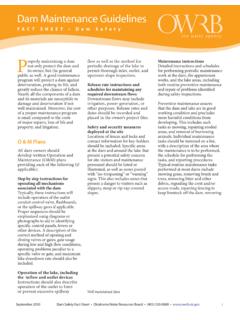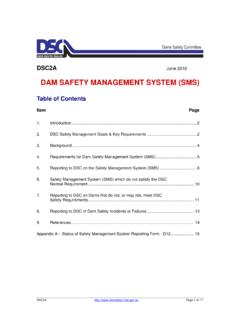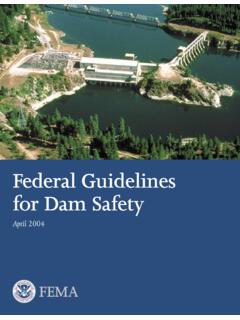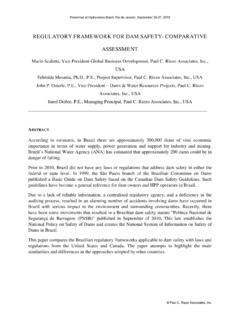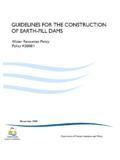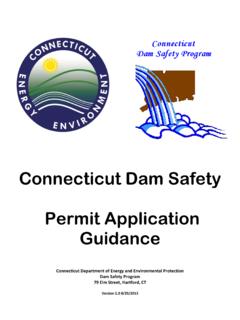Transcription of Guidelines for Maintenance and Inspection of Dams
1 ACKNOWLEDGMENTS. The Division of Water wishes to express its gratitude to the following: Mr. Harry Keith Honaker, , formerly with Kentucky Division of Water, for the compilation of this publication. Dr. George F. Sowers, Regents Professor of Civil Engineering, Georgia Institute of Technology;. Chairman of the Board/Consultant, Law Engineering Testing Company, Atlanta, Georgia, for the information on Earth Dam Failures. Dr. Bruce A. Tschantz, Associate Professor of Civil Engineering, University of Tennessee, for his valuable assistance, information, and comments on the contents of this booklet.
2 Dr. Staley F. Adams, Professor of Civil Engineering, University of Kentucky and students in the Division of Water Training Program at the University of Kentucky for the assistance in compiling the information and illustrations. The Engineering Foundation Conference and Dr. Sanford S. Cole for the information obtained from conferences held by the Engineering Foundation on Dam Safety. The Federal Emergency Management Agency for funds to reprint the publication; the views expressed in this publication are not necessarily those of the funding agency. Other state agencies for information including invaluable lessons learned through experience.
3 (ii). 1. INTRODUCTION. Guidelines for Maintenance and Inspection of Dams was prepared to help you maintain and inspect your dam on a regular schedule to detect problems and prevent a failure of the dam. Experience in Kentucky and other states shows that when dams are not properly maintained, it's usually because the owners don't understand the techniques necessary for a Maintenance program. Understanding and following the Guidelines in this booklet may prevent a catastrophic failure of your dam. 2. GENERAL INFORMATION. A. WHAT IS A DAM ? Kentucky statutes (KRS ) defines a dam as any artificial barrier (including appurtenant works) which does, or can, impound or divert water and is, or will be: (1) twenty-five feet or more high from the natural bed of the stream or watercourse at the downstream tow of the barrier, as determined by the Department for Environmental Protection, or (2) has, or will have an impounding capacity of fifty acre-feet or more at the maximum water storage elevation.
4 B. STATE PERMITS AND INSPECTIONS. Since 1948 anyone in Kentucky proposing to construct a dam has been required to submit a plan to the state for review to obtain a permit. In 1966, adoption of Guidelines for evaluating dams was required by a revision made to the law. In 1974, the permit system was revised to include regular state inspections of dams . KRS directs the Secretary of the Natural Resources and Environmental Protection Cabinet to inspect dams and reservoirs on a regular schedule. C. REGULAR Maintenance AND Inspection IS ESSENTIAL. A dam failure can cause considerable loss of capital investment, loss of income, and even tragic loss of life.
5 Some lakes have existed for such a long time that their pools have been accepted as the natural level, and many homes, industries and utilities rely on the Maintenance of the lake at the existing level. They depend on the owner to properly operate, maintain and inspect the dam to prevent the creation of hazardous conditions to downstream properties and residents. Aside from moral obligation to keep the dam safe, the owner could be subjected to liability claims, or even criminal charges, if the dam fails. So it's good business practice to have an effective program of maintaining and inspecting you dam.
6 This booklet will help you to inspect your dam, but it's not intended as a design manual for making repairs. Use it to tell you when to call in a professional. Remember that all problems may not be exposed in the course of your Maintenance and visual Inspection . Do not rely on home remedies . Call in an experienced design engineer to remedy problems. 3. PROMINENT TYPES OF DAM FAILURE. Dam failures are usually produced by improper design, construction, and Maintenance . All dams built in the future must follow Guidelines in the regulations, and problems will hopefully be minimized.
7 On many older dams, very little is known about their design and construction, so most conclusions are based on knowledge from superficial inspections. With these older structures it is important to be aware of the prominent types of failures and the tell-tale signs the may warn you of failure. Earth dam failures can generally be grouped into three classifications, briefly described below: A. HYDRAULIC FAILURE: Hydraulic failures result from the uncontrolled flow of water over the dam, around the dam, and adjacent to the dam, plus the erosive action of water on the dam and its foundation.
8 Earth dams are particularly susceptible to hydraulic failure since earth erodes at relatively small velocities. B. SEEPAGE FAILURE: All dams exhibit some seepage, which must be controlled in velocity and amount. Seepage occurs both through the dam and the foundation. If uncontrolled, it can erode material from the foundation of an earth dam to forma conduit through which water can pass, which often leads to complete failure of the structure. This phenomenon is known as piping . C. STRUCTURAL FAILURE: Structural failure involves the rupture of the dam and/or its foundation.
9 This is particularly a hazard for large dams and for dams built of low strength materials such as silts, slag, fly ash, etc. Dam failures generally result from a complex interrelationship of these failure modes. Uncontrolled seepage may weaken the soils and lead to a structural failure. A structural failure may shorten the seepage path and lead to piping failure. Surface erosion may lead to structural or piping failures. Tables I, II and III give a summary of failure and possible remedies. 4. WHAT ARE THE MAIN ELEMENTS OF A DAM? The main elements of an earth-fill dam and most dams in Kentucky are earth-fill dams are the embankment and foundation, the principal or mechanical spillway, the emergency spillway, and the drawdown facility.
10 The following descriptions of these elements will acquaint you with the nomenclature, or terms, used in the parts of this booklet on Maintenance and Inspection . Figure 1 shows the elements of a typical earth dam and illustrates the nomenclature followed in this booklet. A. The embankment is the primary part of the dam. It's the section which impounds the lake and holds the water. Earth-fill embankments fall into two main classifications: homogeneous and zoned. A homogeneous embankment is composed of essentially the same material throughout, while a zoned embankment is divided into zones where different materials, such as rock, are incorporated into some areas.




